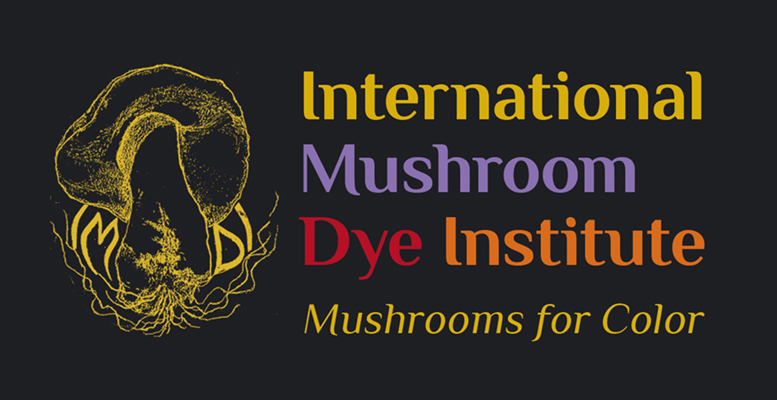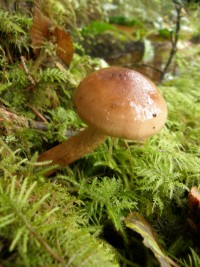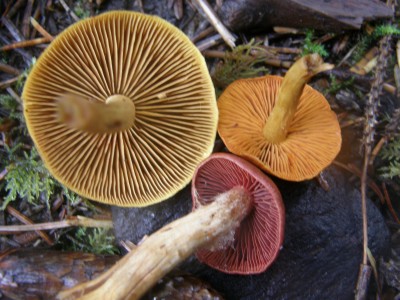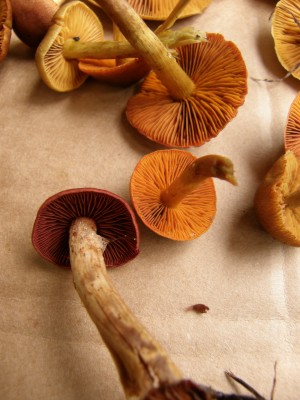
TONGASS
RAINFOREST
FESTIVAL
Petersburg, Alaska 2008
MUSHROOM DYE WORKSHOP
September 7, 2008
(Poster Design by Annabelle Baker)
The Mushroom Dye class was one small part of the festival celebrating the diversity of the Tongass Rainforest in Petersburg, Alaska.
Though fungi were an important focus of this gathering, the emphasis was on the interwoven texture of the Tongass National Forest as an interconnected whole – trees, lichens, ferns, shrubs, wildflowers, birds, seashore life and fungi were all an integral part of the warp and weft of this richly texured fabric, with insight into the ethnobotanical uses of all of these aspects by the peoples of the First Nations. Experts in these fields gave individual talks, lectures and workshops throughout the 3 days of festivities, and led forays with many of them in attendance contributing morsels from their fields as we walked through the forests presenting a very rich menu of experience for the Festival attendees.
And of course those of us who focused on the possibility of mushroom dyes took many forays into the Sitka Spruce forests looking for the elusive Dermocybes and Hydnellums for our dyebaths.
Though our Petersburg dye workshop was only 3 hours long, we collected enough fungi for a wonderful selection of color, which I share with you below. Of course, the red-gilled Dermocybes showed up AFTER I left the area, but the enthusiastic mushroom dyers of Petersburg continue to experiment with new fungi and to send me updates and photos of their finds. I will add those in as they arrive.
by Dorothy Beebee, Mushroom Dye Institute
Dye Mushrooms | Mushroom Dye Samples |
Orange-gilled Dermocybes These brilliantly colored mushrooms were collected in the Petersburg spruce forests and initially appeared to be similar to the ones which were found for the dye workshops up in Cordova the week before, yet these dyes seemed much more intense, especially on the pre-mordanted samples of silk and mohair, therefore probably contained a different set of pigments. Were they Dermocybe croceafolia or Dermocybe crocea or....? Another difference was that the caps and stalks seemed to produce the SAME intense range of color, which was not the case in Cordova, where only the caps produced brilliant color that was intensified by changing the pH more toward acidic. These young Dermocybes had brilliant orange gills, which darken with age as the rusty brown spores mature. The orange-gilled Dermocybes were divided by the dyers into 2 groups for 2 dyebaths - one group consisting only of caps, the other group of only the mushroom stalks. These 2 groups were put into 2 wide-mouthed canning jars which were placed into a bath of simmering water in a large canning pot, for about 45 minutes. The left over dyebaths continued to produce many billiant yellow-orange afterbaths on wool and silk for Karen several days after the Petersburg workshop. (Photos by Karen Dillman) | Top group of wool and silk samples were dyed with the caps only of this orange-gilled Dermocybe. This lower group of samples were dyed with only the stalks of the orange-gilled Dermocybes... |
Hydnellum suaveolans note the bright blue-violet stalk! (Photo by Dorothy Beebee) One of the key features of this lovely velvety toothed fungus was its distinctive "perfumed" fragrance which some of us could distinguish while just walking through the spruce woods or along the roadside banks under Sitka Spruce. Another was the startling blue-violet stipe (stalk). Spore print was a dark brown. These 3 field charactersitics made it an easy one to distringuish from the Phellodon atrata which is very similar in surface appearance in its early stages of growth.In contrast, Phellodon atrata has a white spore print and is not as aromatic. | (Photo by Karen Dillman) We decided to separate the caps and the blue-violet stalks of this very fragrant Hydnellum, and make our initial dye with just the stalks. The caps were put aside for another later dye, which we were unable to get to that day, but which were experimented with by Karen in following days with much the same results as above. |
Hydnellum peckii (Photos by Karen Dillman) This toothed mushroom is distinguished by having dark red drops of liquid on the cap when it is very young, small pinkish-white "blob" on the ground. As it matures, these drops disappear and it matures into a dark reddish brown concave shape with pinkish -beige edges. Older mushrooms are purported to make a stronger dye. The specimens that we used were relatively young and were easy to spot along the banks of the roadsides, growing in a Sitka spruce, "Devil's Club" and blueberry habitat. | We used approximately 1/4 of a grocery bag of fresh, broken up mushrooms. Immersed the fungi and premordanted yarn samples all together in large pot of preheated water (pH +5). Color began to run immediately. After simmering for about 1 hour, samples were removed, rinsed in soapy water (to increase the alkalinity effect) and hung to dry. We then placed a larger skein of alum pre-mordanted wool (top yarn strand in sample above), added 6 T of ammonia which barely changed the pH (the ammonia may have been too old...), then decided to add 1 T. white vinegar to bring the pH down to 4, which tended to change that new wool skein toward mauve. (from notes by Karen Dillman) |

Some of the visiting specialists at the Tongass Rainforest Festival: (from left to right)
Dr. Mary Stensvold – USFS, Sitka,Alaska (Ferns of S.E. Alaska)
Dorothy Beebee – International Mushroom Dye Institute, Forestville, CA
Dr. Nancy Turner – University of Victoria, Britsh Columbia, Canada, (The Culture of forests: Indigenous Knowledge, Use and Stewardship of North Coast Rainforests)
Dr. Paul Hennon, USFS Forest Services Lab, Juneau, Alaska (Ecology of Wood Decaying Fungi in Coastal Rainforests)
Karen Dillman,(the photographer!) Lichenologist, USFS, Petersburg, Alaska
After I left Petersburg… these were some of the Dermocybes found by Karen!

(Photo by Karen Dillman)
Many thanks to Karen Dillman for all of these great photos. We are waiting for more to be sent from other Petersburg mushroom dyers!


















